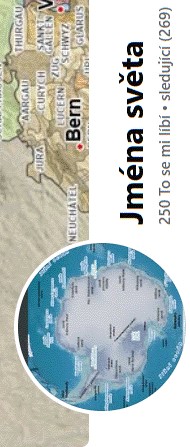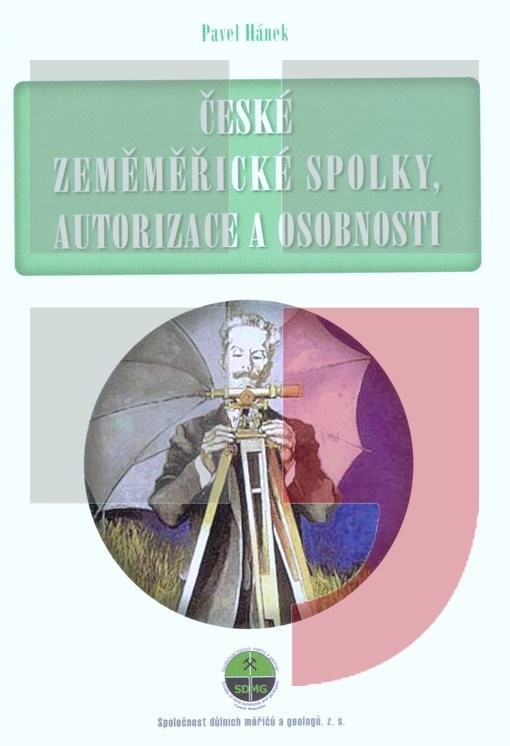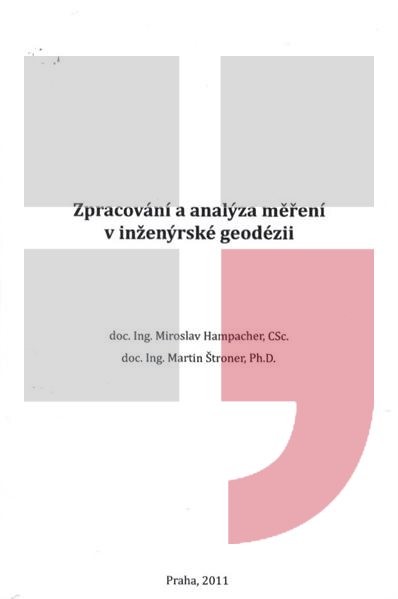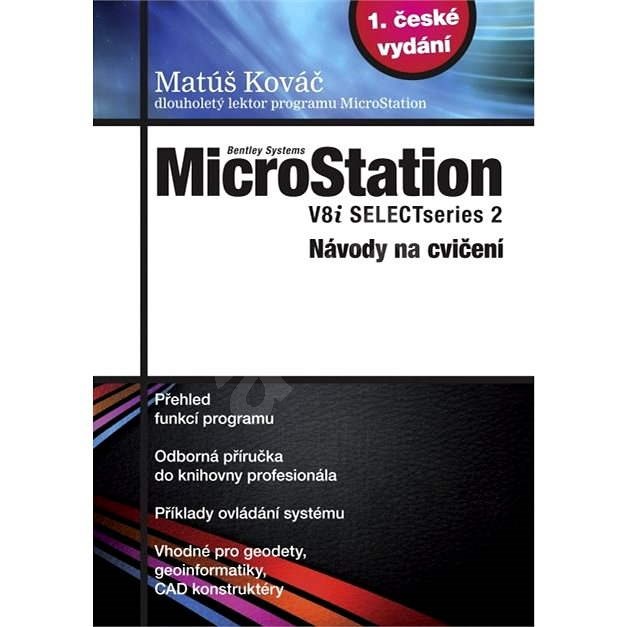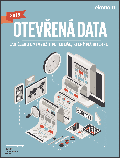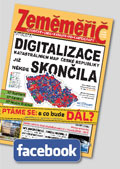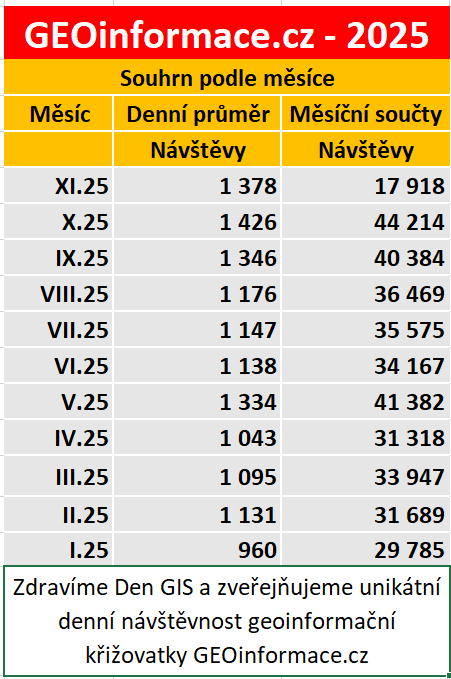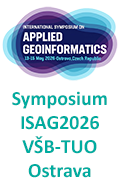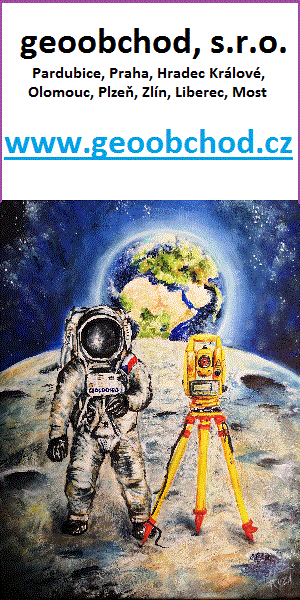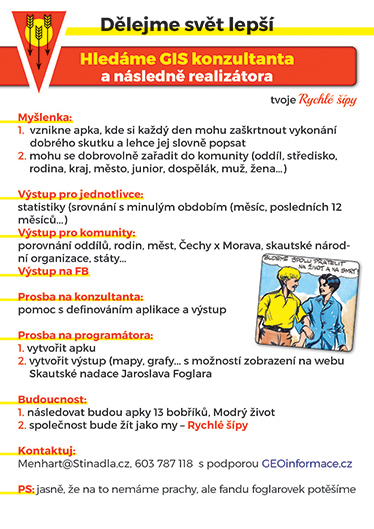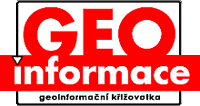zprávy
zdroje zpráv:POZVÁNKA NA OSSCONF 2024
24.5.2024 14:39 Katedra geoinformatiky UP OlomoucPOZVÁNKA NA OSSCONF 2024 Dátum: 1.-3. júla 2024 Miesto: Fakulta riadenia a informatiky Žilinskej univerzity, Žilina Srdečne vás pozývame na OSSConf 2024, kde sa stretnú nadšenci open source technológií. Tento rokje zameranie konferencie na LaTeX, R, Open AI, OSS vo vzdelávaní, Open hardvér, a mnoho ďalších. Hlavná téma: Umelá inteligencia vo vzdelávaní – diskusie o […]
The post POZVÁNKA NA OSSCONF 2024 first appeared on Katedra geoinformatiky.
Watch EarthCARE launch live
24.5.2024 13:45 ESA Observing the Earth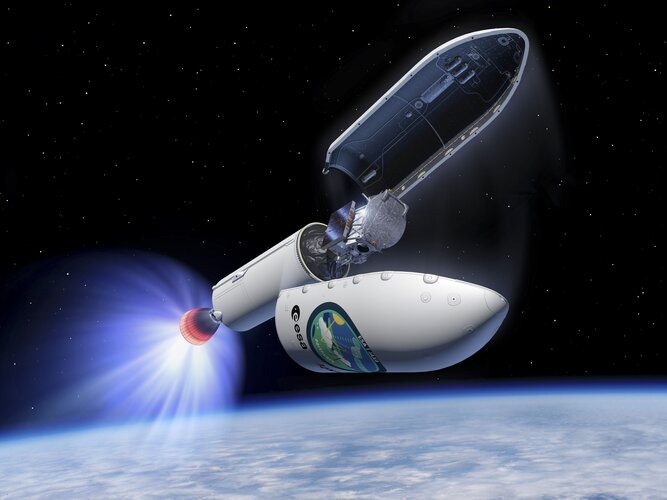
ESA’s Earth Cloud Aerosol and Radiation Explorer (EarthCARE) mission is getting ready for lift-off on a SpaceX Falcon 9 from Vandenberg, California, with a target launch date of no earlier than 28 May 2024. Save the date and watch the launch live on ESA WebTV or ESA YouTube.
Watch EarthCARE launch live
24.5.2024 13:45 ESA Observing the Earth
ESA’s Earth Cloud Aerosol and Radiation Explorer (EarthCARE) mission is getting ready for lift-off on a SpaceX Falcon 9 from Vandenberg Space Force Base, California, with a target launch date of no earlier than 28 May 2024. Save the date and watch the launch live on ESA WebTV or ESA YouTube.
Unravelling the mysteries of clouds
24.5.2024 12:00 ESA Observing the Earth Video:
00:04:07
Video:
00:04:07
Clouds are one of the biggest mysteries in the climate system. They play a key role in the regulating the temperature of our atmosphere. But we don’t know how their behaviour will change over time as Earth’s atmosphere gets warmer. This is where EarthCARE comes in.
Launching on 28 May 2024, ESA’s Earth Cloud, Aerosol and Radiation Explorer will help quantify the role that clouds and aerosols play in heating and cooling Earth’s atmosphere. With its suite of four cutting-edge instruments, EarthCARE is a groundbreaking advancement in satellite technology.
It promises to deliver unprecedented data – unravelling the complexities of both clouds and aerosols. With this, we can refine our atmospheric models and climate forecasts, giving us the tools to tackle the challenges of a changing climate with greater accuracy and precision.
Watch EarthCARE launch live on ESA WebTV or ESA YouTube. For more information on how to stream the launch, click here.
Unravelling the mysteries of clouds
24.5.2024 12:00 ESA Observing the Earth Video:
00:04:07
Video:
00:04:07
Clouds are one of the biggest mysteries in the climate system. They play a key role in the regulating the temperature of our atmosphere. But we don’t know how their behaviour will change over time as Earth’s atmosphere gets warmer. This is where EarthCARE comes in.
Launching on 28 May 2024, ESA’s Earth Cloud, Aerosol and Radiation Explorer will help quantify the role that clouds and aerosols play in heating and cooling Earth’s atmosphere. With its suite of four cutting-edge instruments, EarthCARE is a groundbreaking advancement in satellite technology.
It promises to deliver unprecedented data – unravelling the complexities of both clouds and aerosols. With this, we can refine our atmospheric models and climate forecasts, giving us the tools to tackle the challenges of a changing climate with greater accuracy and precision.
Watch EarthCARE launch live on ESA WebTV or ESA YouTube. For more information on how to stream the launch, click here.
Unravelling the mysteries of clouds
24.5.2024 12:00 ESA Observing the Earth Video:
00:04:07
Video:
00:04:07
Clouds are one of the biggest mysteries in the climate system. They play a key role in the regulating the temperature of our atmosphere. But we don’t know how their behaviour will change over time as Earth’s atmosphere gets warmer. This is where EarthCARE comes in.
Launching on 28 May 2024, ESA’s Earth Cloud, Aerosol and Radiation Explorer will help quantify the role that clouds and aerosols play in heating and cooling Earth’s atmosphere. With its suite of four cutting-edge instruments, EarthCARE is a groundbreaking advancement in satellite technology.
It promises to deliver unprecedented data – unravelling the complexities of both clouds and aerosols. With this, we can refine our atmospheric models and climate forecasts, giving us the tools to tackle the challenges of a changing climate with greater accuracy and precision.
Watch EarthCARE launch live on ESA WebTV or ESA YouTube. For more information on how to stream the launch, click here.
Earth from Space: Changing Iceland in colour
24.5.2024 10:00 ESA Observing the Earth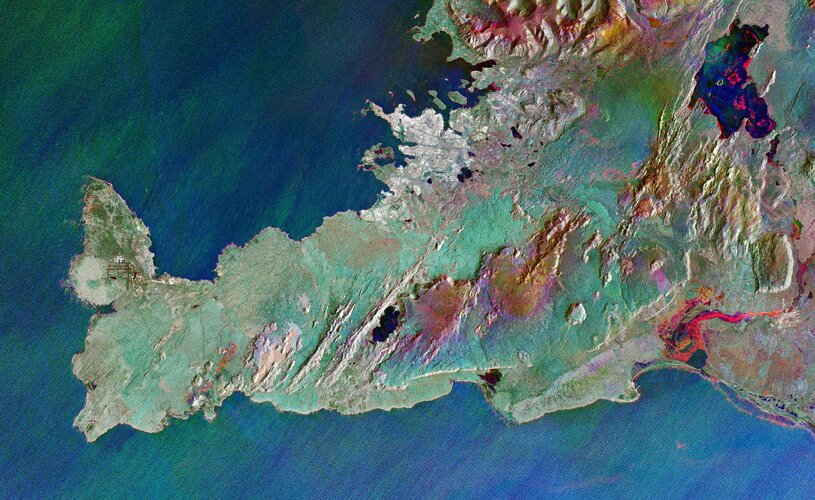 Image:
Iceland's Reykjanes Peninsula is featured in this colourful radar image captured by Copernicus Sentinel-1.
Image:
Iceland's Reykjanes Peninsula is featured in this colourful radar image captured by Copernicus Sentinel-1.
Best Map Award 2023
23.5.2024 15:50 Katedra geoinformatiky UP OlomoucMapy vytvořené našimi odborníky byly oceněny v mezinárodní soutěži Best Map Award 2023! ️ Velké gratulace patří Karlu Macků a Radku Barvířovi za jejich vítěznou práci „Quality of Life Indices: How Robust Are the Results Considering Different Aggregation Techniques?“ Další nominovanou mapou byla Geoparticipation in the Czech Municipalities: Index Based Quantitative Approach – Jaroslav Burian, […]
The post Best Map Award 2023 first appeared on Katedra geoinformatiky.
Plánovaná odstávka Portálu ESKN
23.5.2024 14:00
ÚGKK SR
Úrad geodézie, kartografie a katastra SR v snahe vylepšiť svoje služby bude realizovať aktualizáciu informačných systémov. Z tohto dôvodu je potrebné kvôli lepšej funkčnosti Portálu ESKN urobiť TECHNICKÚ ODSTÁVKU. Dňa 24.05.2024 (piatok) od 18:00 hod. do 27.05.2024 (pondelok) do 12:00 hod. bude technická odstávka elektronických služieb katastra nehnuteľností, nakoľko bude realizovaná aktualizácia infraštruktúry systému elektronických služieb katastra nehnuteľností.
#PortálESKN #od:24.05.2024@18:00 #do:27.05.2024@12:00
Odborný referent / vrchní referent - budování podrobných bodových polí v oddělení obnovy katastráln
23.5.2024 13:39 ČÚZK /Urady/Katastralni-urady/Katastralni-urady/Katastralni-urad-pro-Zlinsky-kraj/Uredni-deska/Oznameni-a-jina-uredni-sdeleni/Volna-mista/DMS/Odborny-referent-vrchni-referent-budovani-podrobnyOdborný referent / vrchní referent - budování podrobných bodových polí v oddělení obnovy katastráln
23.5.2024 13:39 ČÚZK - předpisy a opatření Katastrální úřad pro Zlínský krajvypisuje výběrové řízení na místo
Odborný referent / vrchní referent - budování podrobných bodových polí v oddělení obnovy katastrálního operátu Katastrálního úřadu pro Zlínský kraj
Odborný referent / vrchní referent - budování podrobných bodových polí v oddělení obnovy katastráln
23.5.2024 13:39 ČÚZK - volná místa Katastrální úřad pro Zlínský kraj vypisuje výběrové řízení na místo Odborný referent / vrchní referent - budování podrobných bodových polí v oddělení obnovy katastrálnOdborný referent / vrchní referent - obnova katastrálního operátu v oddělení obnovy katastrálního op
23.5.2024 13:31 ČÚZK /Urady/Katastralni-urady/Katastralni-urady/Katastralni-urad-pro-Zlinsky-kraj/Uredni-deska/Oznameni-a-jina-uredni-sdeleni/Volna-mista/DMS/Odborny-referent-vrchni-referent-obnova-katastralnOdborný referent / vrchní referent - obnova katastrálního operátu v oddělení obnovy katastrálního op
23.5.2024 13:31 ČÚZK - předpisy a opatření Katastrální úřad pro Zlínský krajvypisuje výběrové řízení na místo
Odborný referent / vrchní referent - obnova katastrálního operátu v oddělení obnovy katastrálního operátu Katastrálního úřadu pro Zlínský kraj
Odborný referent / vrchní referent - obnova katastrálního operátu v oddělení obnovy katastrálního op
23.5.2024 13:31 ČÚZK - volná místa Katastrální úřad pro Zlínský kraj vypisuje výběrové řízení na místo Odborný referent / vrchní referent - obnova katastrálního operátu v oddělení obnovy katastrálního opMuzeum map Zlín (pozvánka)
23.5.2024 11:52 GISportal.cz
V úterý 28. května 2024 v 10:00 proběhne ve Zlíně na ulici Vodní 1972 slavnostní otevření Muzea map. Jeho cílem je seznámit veřejnost s výjimečností kartografie a zároveň podpořit rozvoj cestovního ruchu v kraji. Těšit se můžete na historické zajímavosti i spoustu interaktivních prvků. Za zrodem muzea, které je svým zaměřením v Evropě poněkud netradiční, […]
The post Muzeum map Zlín (pozvánka) appeared first on GISportal.cz.
Muzeum map Zlín (pozvánka)
23.5.2024 11:52 GISportal.cz
V úterý 28. května 2024 v 10:00 proběhne ve Zlíně na ulici Vodní 1972 slavnostní otevření Muzea map. Jeho cílem je seznámit veřejnost s výjimečností kartografie a zároveň podpořit rozvoj cestovního ruchu v kraji. Těšit se můžete na historické zajímavosti i spoustu interaktivních prvků. Za zrodem muzea, které je svým zaměřením v Evropě poněkud netradiční, […]
The post Muzeum map Zlín (pozvánka) appeared first on GISportal.cz.
Odborný referent/vrchní referent v oddělení dokumentace KN na Katastrálním pracovišti Znojmo
23.5.2024 10:34 ČÚZK /Urady/Katastralni-urady/Katastralni-urady/Katastralni-urad-pro-Jihomoravsky-kraj/Uredni-deska/Oznameni-a-jina-uredni-sdeleni/Volna-mista/DMS/Odborny-referent-vrchni-referent-v-oddeleni-do-(1)Odborný referent/vrchní referent v oddělení dokumentace KN na Katastrálním pracovišti Znojmo
23.5.2024 10:34 ČÚZK - předpisy a opatření Katastrální úřad pro Jihomoravský kraj Katastrální pracoviště Znojmovypisuje výběrové řízení na místo
Odborný referent/vrchní referent v oddělení dokumentace KN na Katastrálním pracovišti Znojmo
Odborný referent/vrchní referent v oddělení dokumentace KN na Katastrálním pracovišti Znojmo
23.5.2024 10:34 ČÚZK - volná místa Katastrální úřad pro Jihomoravský kraj Katastrální pracoviště Znojmo vypisuje výběrové řízení na místo Odborný referent/vrchní referent v oddělení dokumentace KN na Katastrálním pracovišti ZnojmoNabídka majetku pro OSS
23.5.2024 9:30 Zeměměřický úřadZeměměřický úřad nabízí nepotřebný majetek k odkupu. Jedná se o
Nabídka majetku pro OSS
Nabídka majetku pro OSS
23.5.2024 9:30 ČÚZK - předpisy a opatřeníZeměměřický úřad nabízí nepotřebný majetek k odkupu. Jedná se o
Nabídka majetku pro OSS
Nabídka majetku pro OSS
23.5.2024 9:30 ČÚZK /Urady/Zememericky-urad/Nabidka-majetku/Nabidka-majetku-pro-OSSOdborný referent/vrchní referent v oddělení aktualizace PI KN na Katastrálním pracovišti Brno - měst
23.5.2024 9:24 ČÚZK - předpisy a opatření Katastrální úřad pro Jihomoravský kraj Katastrální pracoviště Brno-městovypisuje výběrové řízení na místo
Odborný referent/vrchní referent v oddělení aktualizace PI KN na Katastrálním pracovišti Brno - město
Odborný referent/vrchní referent v oddělení aktualizace PI KN na Katastrálním pracovišti Brno - měst
23.5.2024 9:24 ČÚZK - volná místa Katastrální úřad pro Jihomoravský kraj Katastrální pracoviště Brno-město vypisuje výběrové řízení na místo Odborný referent/vrchní referent v oddělení aktualizace PI KN na Katastrálním pracovišti Brno - městOdborný referent/vrchní referent v oddělení aktualizace PI KN na Katastrálním pracovišti Brno - měst
23.5.2024 9:24 ČÚZK /Urady/Katastralni-urady/Katastralni-urady/Katastralni-urad-pro-Jihomoravsky-kraj/Uredni-deska/Oznameni-a-jina-uredni-sdeleni/Volna-mista/DMS/Odborny-referent-vrchni-referent-v-oddeleni-ak-(1)Odborný referent v oddělení dokumentace KN na Katastrálním pracovišti Hustopeče
23.5.2024 9:20 ČÚZK - předpisy a opatření Katastrální úřad pro Jihomoravský kraj - Katastrální pracoviště Hustopečevypisuje výběrové řízení na místo
Odborný referent v oddělení dokumentace KN na Katastrálním pracovišti Hustopeče
Odborný referent v oddělení dokumentace KN na Katastrálním pracovišti Hustopeče
23.5.2024 9:20 ČÚZK - předpisy a opatření Katastrální úřad pro Jihomoravský kraj Katastrální pracoviště Hustopečevypisuje výběrové řízení na místo
Odborný referent v oddělení dokumentace KN na Katastrálním pracovišti Hustopeče
Odborný referent v oddělení dokumentace KN na Katastrálním pracovišti Hustopeče
23.5.2024 9:20 ČÚZK - volná místa Katastrální úřad pro Jihomoravský kraj vypisuje výběrové řízení na místo Odborný referent v oddělení dokumentace KN na Katastrálním pracovišti HustopečeOdborný referent v oddělení dokumentace KN na Katastrálním pracovišti Hustopeče
23.5.2024 9:20 ČÚZK /Urady/Katastralni-urady/Katastralni-urady/Katastralni-urad-pro-Jihomoravsky-kraj/Uredni-deska/Oznameni-a-jina-uredni-sdeleni/Volna-mista/DMS/Odborny-referent-v-oddeleni-dokumentace-KN-na-KataOdborný referent v oddělení dokumentace KN na Katastrálním pracovišti Hustopeče
23.5.2024 9:20 ČÚZK - volná místa Katastrální úřad pro Jihomoravský kraj - Katastrální pracoviště Hustopeče vypisuje výběrové řízení na místo Odborný referent v oddělení dokumentace KN na Katastrálním pracovišti HustopečeOdborný referent v oddělení dokumentace KN na Katastrálním pracovišti Hustopeče
23.5.2024 9:20 ČÚZK - volná místa Katastrální úřad pro Jihomoravský kraj Katastrální pracoviště Hustopeče vypisuje výběrové řízení na místo Odborný referent v oddělení dokumentace KN na Katastrálním pracovišti HustopečeOdborný referent/vrchní referent v oddělení dokumentace KN na Katastrálním pracovišti Hustopeče
23.5.2024 9:18 ČÚZK - předpisy a opatření Katastrální úřad pro Jihomoravský kraj Katastrální pracoviště Hustopečevypisuje výběrové řízení na místo
Odborný referent/vrchní referent v oddělení dokumentace KN na Katastrálním pracovišti Hustopeče
Odborný referent/vrchní referent v oddělení dokumentace KN na Katastrálním pracovišti Hustopeče
23.5.2024 9:18 ČÚZK - volná místa Katastrální úřad pro Jihomoravský kraj - Katastrální pracoviště Hustopeče vypisuje výběrové řízení na místo Odborný referent/vrchní referent v oddělení dokumentace KN na Katastrálním pracovišti HustopečeOdborný referent/vrchní referent v oddělení dokumentace KN na Katastrálním pracovišti Hustopeče
23.5.2024 9:18 ČÚZK - volná místa Katastrální úřad pro Jihomoravský kraj vypisuje výběrové řízení na místo Odborný referent/vrchní referent v oddělení dokumentace KN na Katastrálním pracovišti HustopečeOdborný referent/vrchní referent v oddělení dokumentace KN na Katastrálním pracovišti Hustopeče
23.5.2024 9:18 ČÚZK - volná místa Katastrální úřad pro Jihomoravský kraj Katastrální pracoviště Hustopeče vypisuje výběrové řízení na místo Odborný referent/vrchní referent v oddělení dokumentace KN na Katastrálním pracovišti HustopečeOdborný referent/vrchní referent v oddělení dokumentace KN na Katastrálním pracovišti Hustopeče
23.5.2024 9:18 ČÚZK - předpisy a opatření Katastrální úřad pro Jihomoravský kraj - Katastrální pracoviště Hustopečevypisuje výběrové řízení na místo
Odborný referent/vrchní referent v oddělení dokumentace KN na Katastrálním pracovišti Hustopeče
Odborný referent/vrchní referent v oddělení dokumentace KN na Katastrálním pracovišti Hustopeče
23.5.2024 9:18 ČÚZK /Urady/Katastralni-urady/Katastralni-urady/Katastralni-urad-pro-Jihomoravsky-kraj/Uredni-deska/Oznameni-a-jina-uredni-sdeleni/Volna-mista/DMS/Odborny-referent-vrchni-referent-v-oddeleni-dokumeIceberg A-83 breaks free
23.5.2024 8:45 ESA Observing the Earth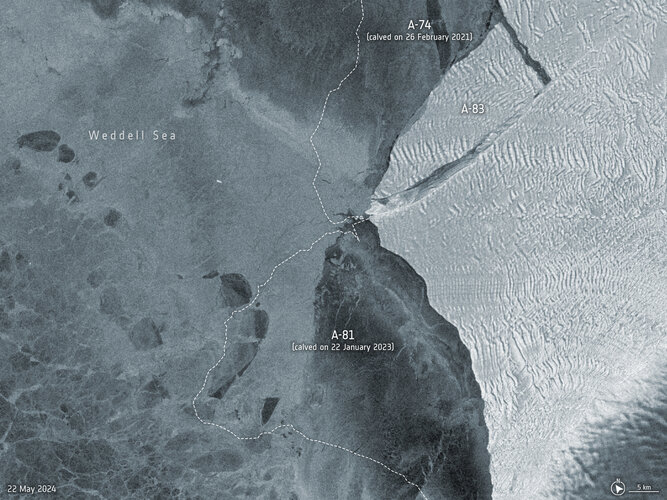 Image:
An iceberg roughly the size of the Isle of Wight has broken off the Brunt Ice Shelf in Antarctica on 20 May.
Image:
An iceberg roughly the size of the Isle of Wight has broken off the Brunt Ice Shelf in Antarctica on 20 May.
Zpřístupnění GP v Nahlížení KN pro geodety
23.5.2024 8:22 ČÚZK - RSS kanál pro zeměměřiče Upozorňujeme, že v rámci Nahlížení do KN pro geodety byla k možnosti stažení souborů ZPMZ nově doplněna rovněž možnost stažení souborů geometrických plánů. Jedná se o prosté kopie geometrických plánů (bez autentizačních prvků) poskytované výhradně odborně způsobilým osobám v režimu podkladů pro vyhotovení geometrického plánu nebo vytyčení hranice pozemků podle katastrální vyhlášky.Zpřístupnění GP v Nahlížení KN pro geodety
23.5.2024 8:22 ČÚZK /Zememerictvi/Zememericke-cinnosti/Aktuality-pro-zememerice/2024/Zpristupneni-GP-v-Nahlizeni-KN-pro-geodetyZpřístupnění GP v Nahlížení KN pro geodety
23.5.2024 8:22 ČÚZK - předpisy a opatření Český úřad zeměměřický a katastrálnízveřejnil novou aktualitu: Upozorňujeme, že v rámci Nahlížení do KN pro geodety byla k možnosti stažení souborů ZPMZ nově doplněna rovněž možnost stažení souborů geometrických plánů. Jedná se o prosté kopie geometrických plánů (bez autentizačních prvků) poskytované výhradně odborně způsobilým osobám v režimu podkladů pro vyhotovení geometrického plánu nebo vytyčení hranice pozemků podle katastrální vyhlášky.
Zpřístupnění GP v Nahlížení KN pro geodety
23.5.2024 8:22 ČÚZK - RSS kanál pro zeměměřiče Upozorňujeme, že v rámci Nahlížení do KN pro geodety byla k možnosti stažení souborů ZPMZ nově doplněna rovněž možnost stažení souborů geometrických plánů. Jedná se o prosté kopie geometrických plánů (bez autentizačních prvků) poskytované výhradně odborně způsobilým osobám v režimu podkladů pro vyhotovení geometrického plánu nebo vytyčení hranice pozemků podle katastrální vyhlášky.Airbus to build ESA’s Vigil space weather forecasting mission
22.5.2024 17:26 ESA Observing the Earth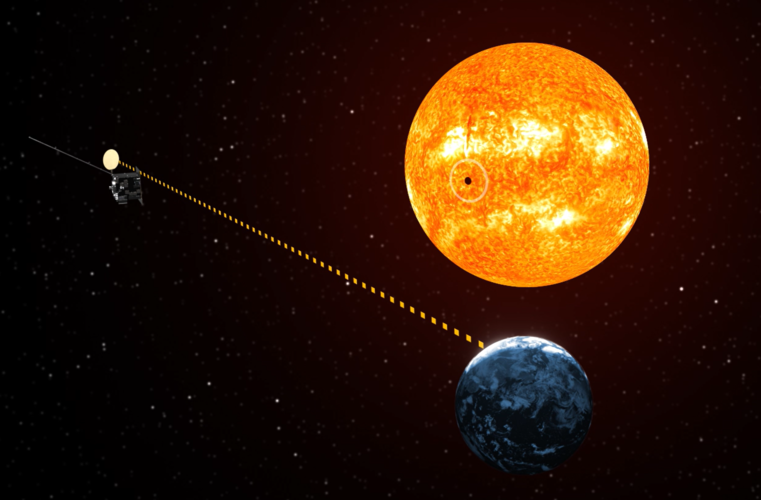
Watch EarthCARE launch live
22.5.2024 13:05 ESA Observing the Earth
ESA’s Earth Cloud Aerosol and Radiation Explorer (EarthCARE) mission is getting ready for lift-off on a SpaceX Falcon 9 from Vandenberg, California, with a target launch date of no earlier than 28 May 2024. Save the date and watch the launch live on ESA WebTV or ESA YouTube.
Fireball witnessed by weather satellite
22.5.2024 10:39 ESA Observing the Earth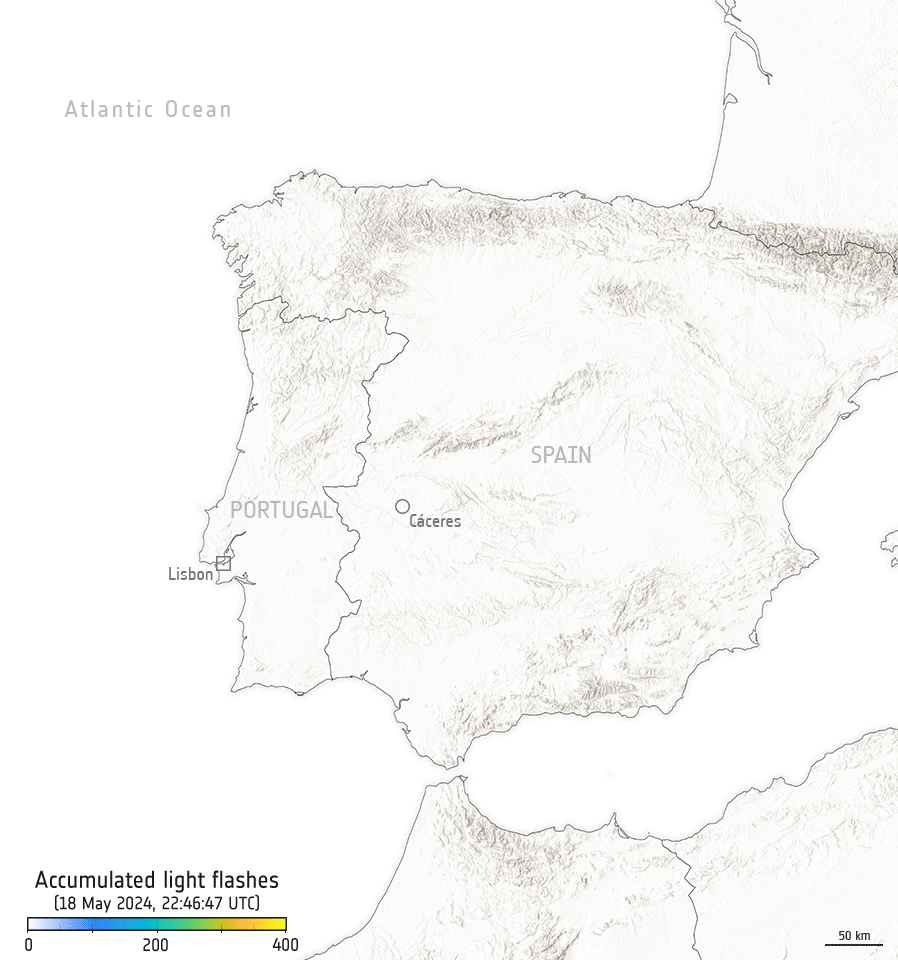
While a meteor lit up the skies over Spain and Portugal recently, it was also captured by the Meteosat Third Generation Imager weather satellite hovering 36,000 km away in geostationary orbit.
Ve Zlíně se otevírá nové Muzeum map
22.5.2024 8:46 Česká kartografická společnostV úterý 28. května 2024 v 10:00 proběhne ve Zlíně na ulici Vodní 1972 slavnostní otevření Muzea map. Jeho cílem je seznámit veřejnost s výjimečností kartografie a zároveň podpořit rozvoj cestovního ruchu v kraji. Těšit se můžete na historické zajímavosti i spoustu interaktivních prvků. Za zrodem muzea, které je svým zaměřením v Evropě poněkud netradiční, […]
The post Ve Zlíně se otevírá nové Muzeum map first appeared on Česká kartografická společnost.
Studenti předmětu Dějiny světové kartografie v mapových sbírkách [Katedra aplikované geoinformatiky a kartografie, byTopic]
21.5.2024 18:45 Katedra aplikované geoinformatiky a kartografie Přf UK V rámci předmětu Dějiny světové kartografie absolvovali studenti v letním semestru 2024 tři exkurze. Dvakrát navštívili Mapovou sbírku PřF UK a jednou Ústřední archiv zeměměřictví a katastru ČÚZK.EarthCARE pre-launch press briefing
21.5.2024 18:00 ESA Observing the Earth Video:
00:51:05
Video:
00:51:05
ESA’s Earth Cloud Aerosol and Radiation Explorer (EarthCARE) mission is designed to advance our understanding of the role that clouds and aerosols play in reflecting incident solar radiation back out to space and trapping infrared radiation emitted from Earth’s surface.
Developed as a cooperation between ESA and the Japan Aerospace Exploration Agency (JAXA), this exciting mission will make a range of different measurements that together will shed new light on the role that clouds and aerosols play in regulating Earth’s delicate temperature balance.
With global climate change increasingly affecting our planet, EarthCARE is poised to provide data for climate research, improve the accuracy of climate models and support numerical weather prediction.
The EarthCare pre-launch press briefing featured: Simonetta Cheli, Director of Earth Observation Programmes, ESA, Dirk Bernaerts, EarthCARE project manager and Acting Head Earth Explorers Division, ESA, Futoshi Takiguchi, Vice President and Director General for the Space Technology Directorate, JAXA, Eiichi Tomita, EarthCARE/CPR Project Manager, JAXA and Maximilian Sauer, EarthCARE Project Manager, Airbus.
odborný/vrchní referent – poskytování informací KN (nahlížení, opisy, kopie)
21.5.2024 15:58 ČÚZK /Urady/Katastralni-urady/Katastralni-urady/Katastralni-urad-pro-hlavni-mesto-Prahu/O-uradu/Aktuality/odborny-vrchni-referent-–-poskytovani-informaci-KNodborný/vrchní referent – poskytování informací KN (nahlížení, opisy, kopie)
21.5.2024 15:58 ČÚZK - předpisy a opatření Katastrální úřad pro hlavní město Prahu zveřejnil novou aktualitu: Ředitelka úřadu vyhlašuje výběrové řízení na pozici:odborný/vrchní referent – poskytování informací KN (nahlížení, opisy, kopie)
odborný/vrchní referent – poskytování informací KN (nahlížení, opisy, kopie)
21.5.2024 15:56 ČÚZK - volná místa Katastrální úřad pro hlavní město Prahu vypisuje výběrové řízení na místo odborný/vrchní referent – poskytování informací KN (nahlížení, opisy, kopie)odborný/vrchní referent – poskytování informací KN (nahlížení, opisy, kopie)
21.5.2024 15:56 ČÚZK - předpisy a opatření Katastrální úřad pro hlavní město Prahuvypisuje výběrové řízení na místo
odborný/vrchní referent – poskytování informací KN (nahlížení, opisy, kopie)
odborný/vrchní referent – poskytování informací KN (nahlížení, opisy, kopie)
21.5.2024 15:56 ČÚZK /Urady/Katastralni-urady/Katastralni-urady/Katastralni-urad-pro-hlavni-mesto-Prahu/Uredni-deska/Oznameni-a-jina-uredni-sdeleni/Volna-mista/odborny-vrchni-referent-–-poskytovani-informaci-KN20240521-VŘ Metodik bezpečnosti
21.5.2024 15:13 ČÚZK - předpisy a opatření Český úřad zeměměřický a katastrální zveřejnil novou aktualitu: Oznámení o vyhlášení výběrového řízení na obsazení služebního místa odborný rada - Metodik/metodička bezpečnosti.20240521-VŘ Metodik bezpečnosti
21.5.2024 15:13 ČÚZK - aktuality v resortu Oznámení o vyhlášení výběrového řízení na obsazení služebního místa odborný rada - Metodik/metodička bezpečnosti.20240521-VŘ Metodik bezpečnosti
21.5.2024 15:13 ČÚZK /Aktuality-resort/2024/20240521-VR-Metodik-bezpecnostiGeoKARTO 2024
21.5.2024 14:04 Komora geodetů a kartografů SRThe post GeoKARTO 2024 appeared first on Komora geodetov a kartografov.
Krátka správa č. 22/2024
21.5.2024 13:56 Komora geodetů a kartografů SRThe post Krátka správa č. 22/2024 appeared first on Komora geodetov a kartografov.
odborný referent / vrchní referent – obnova katastrálního operátu
21.5.2024 13:42 ČÚZK - volná místa Katastrální úřad pro Olomoucký kraj Katastrální pracoviště Přerov vypisuje výběrové řízení na místo odborný referent / vrchní referent – obnova katastrálního operátuodborný referent / vrchní referent – obnova katastrálního operátu
21.5.2024 13:42 ČÚZK - předpisy a opatření Katastrální úřad pro Olomoucký kraj Katastrální pracoviště Přerovvypisuje výběrové řízení na místo
odborný referent / vrchní referent – obnova katastrálního operátu
GIS Trainee & GIS Developer ve Stora Enso
21.5.2024 12:20 Katedra geoinformatiky UP OlomoucHledáme kolegu do společnosti Stora Enso na pozici GIS Trainee. Prvním úkolem této pozice je sběr a analýza trénovacích dat pro vývoj modelů hlubokého učení ze satelitních a dronových snímků, vhodné i jako letní brigáda. Náplň práce zahrnuje identifikaci stromů na snímcích, jejich přesnou anotaci a přípravu dat pro další zpracování. Součástí Vaší budoucí pozice […]
The post GIS Trainee & GIS Developer ve Stora Enso first appeared on Katedra geoinformatiky.
Vrchní referent/rada – kontrola aktualizace
21.5.2024 11:00 ČÚZK - předpisy a opatření Katastrální úřad pro Moravskoslezský kraj Katastrální pracoviště Karvinávypisuje výběrové řízení na místo
Vrchní referent/rada – kontrola aktualizace
Vrchní referent/rada – kontrola aktualizace
21.5.2024 11:00 ČÚZK - volná místa Katastrální úřad pro Moravskoslezský kraj Katastrální pracoviště Karviná vypisuje výběrové řízení na místo Vrchní referent/rada – kontrola aktualizaceVrchní referent/rada – kontrola aktualizace
21.5.2024 11:00 ČÚZK /Urady/Katastralni-urady/Katastralni-urady/Katastralni-urad-pro-Moravskoslezsky-kraj/Uredni-deska/Oznameni-a-jina-uredni-sdeleni/Volna-mista/DMS/Vrchni-referent-rada-–-kontrola-aktualizace20240521-VŘ - KP Bruntál
21.5.2024 8:44 ČÚZK - aktuality v resortu Oznámení o vyhlášení výběrových řízení na obsazení služebních míst ředitele/ředitelky Katastrálního pracoviště Krnov a Katastrálního pracoviště Bruntál.20240521-VŘ - KP Bruntál
21.5.2024 8:44 ČÚZK - předpisy a opatření Český úřad zeměměřický a katastrální zveřejnil novou aktualitu: Oznámení o vyhlášení výběrových řízení na obsazení služebních míst ředitele/ředitelky Katastrálního pracoviště Krnov a Katastrálního pracoviště Bruntál.20240520_odborný rada v oddělení aktualizace KN
20.5.2024 13:01 ČÚZK - předpisy a opatření Katastrální úřad pro Středočeský kraj - Katastrální pracoviště Benešov Vyhlášení výběrového řízení: odborný rada v oddělení aktualizace KN V části "Úřední deska", v sekci "Oznámení a jiná úřední sdělení" bylo vystaveno "Oznámení o vyhlášení výběrového řízení na obsazení služebního místa Odborný referent oddělení aktualizace KN"20240520_odborný rada v oddělení aktualizace KN
20.5.2024 13:01 ČÚZK /Urady/Katastralni-urady/Katastralni-urady/Katastralni-urad-pro-Stredocesky-kraj/Katastralni-pracoviste/KP-Benesov/O-uradu/Aktuality/20210922_Odborny-referent-oddeleni-aktualizace-(2)Data visualization | Romania city view by Lixel X1
20.5.2024 12:41 Satlab Geosolutions
The post Data visualization | Romania city view by Lixel X1 appeared first on Global Satellite Positioning Solutions | SatLab Geosolutions AB.
Data visualization | Romania city view by Lixel X1
20.5.2024 12:29 Satlab Geosolutions
The post Data visualization | Romania city view by Lixel X1 appeared first on Global Satellite Positioning Solutions | SatLab Geosolutions AB.
Satsurv Surveying Software Update | What’s new in V3.1.0?
20.5.2024 12:27 Satlab GeosolutionsThe post Satsurv Surveying Software Update | What’s new in V3.1.0? appeared first on Global Satellite Positioning Solutions | SatLab Geosolutions AB.
Quick Start Guide | Install APUS UAV LIDAR on DJI M300 in under 5 Minutes!
20.5.2024 12:22 Satlab Geosolutions
The post Quick Start Guide | Install APUS UAV LIDAR on DJI M300 in under 5 Minutes! appeared first on Global Satellite Positioning Solutions | SatLab Geosolutions AB.
Sat-Live Day | HydroBoat 1200 in Hong Kong
20.5.2024 12:16 Satlab Geosolutions
The post Sat-Live Day | HydroBoat 1200 in Hong Kong appeared first on Global Satellite Positioning Solutions | SatLab Geosolutions AB.
Partner Success Studies | SLAM to BIM Solution
20.5.2024 12:13 Satlab Geosolutions
The post Partner Success Studies | SLAM to BIM Solution appeared first on Global Satellite Positioning Solutions | SatLab Geosolutions AB.
APUS UAV LiDAR System | Beyond Boundaries
20.5.2024 12:11 Satlab Geosolutions
The post APUS UAV LiDAR System | Beyond Boundaries appeared first on Global Satellite Positioning Solutions | SatLab Geosolutions AB.
Apus UAV LiDAR System | Beyond Boundaries
20.5.2024 12:11 Satlab Geosolutions
The post Apus UAV LiDAR System | Beyond Boundaries appeared first on Global Satellite Positioning Solutions | SatLab Geosolutions AB.
[Webinar] – APUS UAV LiDAR Overview | Beyond Boundaries
20.5.2024 12:09 Satlab Geosolutions
The post [Webinar] – APUS UAV LiDAR Overview | Beyond Boundaries appeared first on Global Satellite Positioning Solutions | SatLab Geosolutions AB.
[Webinar] – Apus UAV LiDAR Overview | Beyond Boundaries
20.5.2024 12:09 Satlab Geosolutions
The post [Webinar] – Apus UAV LiDAR Overview | Beyond Boundaries appeared first on Global Satellite Positioning Solutions | SatLab Geosolutions AB.
Office & Factory Tour | Geosolution i Göteborg AB
20.5.2024 12:06 Satlab Geosolutions
The post Office & Factory Tour | Geosolution i Göteborg AB appeared first on Global Satellite Positioning Solutions | SatLab Geosolutions AB.
Saloma Link Bridge point cloud by Lixel X1 LiDAR scanner
20.5.2024 12:00 Satlab Geosolutions
The post Saloma Link Bridge point cloud by Lixel X1 LiDAR scanner appeared first on Global Satellite Positioning Solutions | SatLab Geosolutions AB.
Data visualization – energy transmission lines inspection
20.5.2024 11:57 Satlab Geosolutions
The post Data visualization – energy transmission lines inspection appeared first on Global Satellite Positioning Solutions | SatLab Geosolutions AB.
Unboxing – Lixel X1 SLAM Scanner
20.5.2024 11:55 Satlab Geosolutions
The post Unboxing – Lixel X1 SLAM Scanner appeared first on Global Satellite Positioning Solutions | SatLab Geosolutions AB.
Industrial zone point cloud by drone-mounted Lixel X1 LiDAR scanner
20.5.2024 11:44 Satlab Geosolutions
The post Industrial zone point cloud by drone-mounted Lixel X1 LiDAR scanner appeared first on Global Satellite Positioning Solutions | SatLab Geosolutions AB.
Data Visualization of Mexico Street – Lixel X1 SLAM scanner
20.5.2024 11:39 Satlab Geosolutions
The post Data Visualization of Mexico Street – Lixel X1 SLAM scanner appeared first on Global Satellite Positioning Solutions | SatLab Geosolutions AB.
Data visualization | Romania city view by Lixel X1 SLAM SCANNER
20.5.2024 11:05 Satlab Geosolutions
The post Data visualization | Romania city view by Lixel X1 SLAM SCANNER appeared first on Global Satellite Positioning Solutions | SatLab Geosolutions AB.
Point Cloud Data Visualization | Cygnus SLAM scanner
20.5.2024 11:05 Satlab Geosolutions
The post Point Cloud Data Visualization | Cygnus SLAM scanner appeared first on Global Satellite Positioning Solutions | SatLab Geosolutions AB.
Partner Success Studies | SLAM to BIM Solution – LiXEL X1 SLAM SCANNER
20.5.2024 11:00 Satlab Geosolutions
The post Partner Success Studies | SLAM to BIM Solution – LiXEL X1 SLAM SCANNER appeared first on Global Satellite Positioning Solutions | SatLab Geosolutions AB.
Rada/odborný rada v oddělení podpory informačních a komunikačních technologií na Technické sekci
20.5.2024 10:57 ČÚZK - předpisy a opatření Katastrální úřad pro Jihomoravský kraj technická sekcevypisuje výběrové řízení na místo
Rada/odborný rada v oddělení podpory informačních a komunikačních technologií na Technické sekci
Rada/odborný rada v oddělení podpory informačních a komunikačních technologií na Technické sekci
20.5.2024 10:57 ČÚZK /Urady/Katastralni-urady/Katastralni-urady/Katastralni-urad-pro-Jihomoravsky-kraj/Uredni-deska/Oznameni-a-jina-uredni-sdeleni/Volna-mista/DMS/Rada-odborny-rada-v-oddeleni-podpory-informacnich-Rada/odborný rada v oddělení podpory informačních a komunikačních technologií na Technické sekci
20.5.2024 10:57 ČÚZK - volná místa Katastrální úřad pro Jihomoravský kraj technická sekce vypisuje výběrové řízení na místo Rada/odborný rada v oddělení podpory informačních a komunikačních technologií na Technické sekciOdborný referent v oddělení právních vztahů k nemovitostem na Katastrálním pracovišti Znojmo
20.5.2024 10:54 ČÚZK - volná místa Katastrální úřad pro Jihomoravský kraj Katastrální pracoviště Znojmo vypisuje výběrové řízení na místo Odborný referent v oddělení právních vztahů k nemovitostem na Katastrálním pracovišti ZnojmoOdborný referent v oddělení právních vztahů k nemovitostem na Katastrálním pracovišti Znojmo
20.5.2024 10:54 ČÚZK /Urady/Katastralni-urady/Katastralni-urady/Katastralni-urad-pro-Jihomoravsky-kraj/Uredni-deska/Oznameni-a-jina-uredni-sdeleni/Volna-mista/DMS/Odborny-referent-v-oddeleni-pravnich-vztahu-k-(1)Odborný referent v oddělení právních vztahů k nemovitostem na Katastrálním pracovišti Znojmo
20.5.2024 10:54 ČÚZK - předpisy a opatření Katastrální úřad pro Jihomoravský kraj Katastrální pracoviště Znojmovypisuje výběrové řízení na místo
Odborný referent v oddělení právních vztahů k nemovitostem na Katastrálním pracovišti Znojmo
Vrchní referent/rada – obnova katastrálního operátu v oddělení aktualizace a dokumentace KN Katastr
20.5.2024 9:43 ČÚZK /Urady/Katastralni-urady/Katastralni-urady/Katastralni-urad-pro-Moravskoslezsky-kraj/Uredni-deska/Oznameni-a-jina-uredni-sdeleni/Volna-mista/DMS/Vrchni-referent-rada-–-obnova-katastralniho-op-(3)Vrchní referent/rada – obnova katastrálního operátu v oddělení aktualizace a dokumentace KN Katastr
20.5.2024 9:43 ČÚZK - volná místa Katastrální úřad pro Moravskoslezský kraj Katastrální pracoviště Třinec vypisuje výběrové řízení na místo Vrchní referent/rada – obnova katastrálního operátu v oddělení aktualizace a dokumentace KN KatastrVrchní referent/rada – obnova katastrálního operátu v oddělení aktualizace a dokumentace KN Katastr
20.5.2024 9:43 ČÚZK - předpisy a opatření Katastrální úřad pro Moravskoslezský kraj Katastrální pracoviště Třinecvypisuje výběrové řízení na místo
Vrchní referent/rada – obnova katastrálního operátu v oddělení aktualizace a dokumentace KN Katastrálního úřadu pro Moravskoslezský kraj, Katastrálního pracoviště Třinec
Odborný referent/vrchní referent – vedení katastrální mapy v oddělení aktualizace a dokumentace KN K
20.5.2024 9:36 ČÚZK /Urady/Katastralni-urady/Katastralni-urady/Katastralni-urad-pro-Moravskoslezsky-kraj/Uredni-deska/Oznameni-a-jina-uredni-sdeleni/Volna-mista/DMS/Odborny-referent-vrchni-referent-–-vedeni-katastraOdborný referent/vrchní referent – vedení katastrální mapy v oddělení aktualizace a dokumentace KN K
20.5.2024 9:36 ČÚZK - volná místa Katastrální úřad pro Moravskoslezský kraj Katastrální pracoviště Karviná vypisuje výběrové řízení na místo Odborný referent/vrchní referent – vedení katastrální mapy v oddělení aktualizace a dokumentace KN KOdborný referent/vrchní referent – vedení katastrální mapy v oddělení aktualizace a dokumentace KN K
20.5.2024 9:36 ČÚZK - předpisy a opatření Katastrální úřad pro Moravskoslezský kraj Katastrální pracoviště Karvinávypisuje výběrové řízení na místo
Odborný referent/vrchní referent – vedení katastrální mapy v oddělení aktualizace a dokumentace KN Katastrálního úřadu pro Moravskoslezský kraj, Katastrálního pracoviště Karviná
Rada/odborný rada – obnova katastrálního operátu v oddělení aktualizace KN Katastrálního úřadu pro M
20.5.2024 9:30 ČÚZK - volná místa Katastrální úřad pro Moravskoslezský kraj Katastrální pracoviště Frýdek-Místek vypisuje výběrové řízení na místo Rada/odborný rada – obnova katastrálního operátu v oddělení aktualizace KN Katastrálního úřadu pro MRada/odborný rada – obnova katastrálního operátu v oddělení aktualizace KN Katastrálního úřadu pro M
20.5.2024 9:30 ČÚZK /Urady/Katastralni-urady/Katastralni-urady/Katastralni-urad-pro-Moravskoslezsky-kraj/Uredni-deska/Oznameni-a-jina-uredni-sdeleni/Volna-mista/DMS/Rada-odborny-rada-–-obnova-katastralniho-operatu-vRada/odborný rada – obnova katastrálního operátu v oddělení aktualizace KN Katastrálního úřadu pro M
20.5.2024 9:30 ČÚZK - předpisy a opatření Katastrální úřad pro Moravskoslezský kraj Katastrální pracoviště Frýdek-Místekvypisuje výběrové řízení na místo
Rada/odborný rada – obnova katastrálního operátu v oddělení aktualizace KN Katastrálního úřadu pro Moravskoslezský kraj, Katastrálního pracoviště Frýdek-Místek
Rada/odborný rada – řízení o opravě chyby SPI v oddělení dokumentace KN Katastrálního úřadu pro Mora
20.5.2024 9:26 ČÚZK - předpisy a opatření Katastrální úřad pro Moravskoslezský kraj Katastrální pracoviště Frýdek-Místekvypisuje výběrové řízení na místo
Rada/odborný rada – řízení o opravě chyby SPI v oddělení dokumentace KN Katastrálního úřadu pro Moravskoslezský kraj, Katastrálního pracoviště Frýdek-Místek
Rada/odborný rada – řízení o opravě chyby SPI v oddělení dokumentace KN Katastrálního úřadu pro Mora
20.5.2024 9:26 ČÚZK /Urady/Katastralni-urady/Katastralni-urady/Katastralni-urad-pro-Moravskoslezsky-kraj/Uredni-deska/Oznameni-a-jina-uredni-sdeleni/Volna-mista/DMS/Rada-odborny-rada-–-rizeni-o-oprave-chyby-SPI-v-odRada/odborný rada – řízení o opravě chyby SPI v oddělení dokumentace KN Katastrálního úřadu pro Mora
20.5.2024 9:26 ČÚZK - volná místa Katastrální úřad pro Moravskoslezský kraj Katastrální pracoviště Frýdek-Místek vypisuje výběrové řízení na místo Rada/odborný rada – řízení o opravě chyby SPI v oddělení dokumentace KN Katastrálního úřadu pro MoraVrchní referent/rada – obnova katastrálního operátu, Katastrální úřad pro Moravskoslezský kraj v odd
20.5.2024 9:23 ČÚZK - volná místa Katastrální úřad pro Moravskoslezský kraj Katastrální pracoviště Bruntál vypisuje výběrové řízení na místo Vrchní referent/rada – obnova katastrálního operátu, Katastrální úřad pro Moravskoslezský kraj v oddVrchní referent/rada – obnova katastrálního operátu, Katastrální úřad pro Moravskoslezský kraj v odd
20.5.2024 9:23 ČÚZK - předpisy a opatření Katastrální úřad pro Moravskoslezský kraj Katastrální pracoviště Bruntálvypisuje výběrové řízení na místo
Vrchní referent/rada – obnova katastrálního operátu, Katastrální úřad pro Moravskoslezský kraj v oddělení aktualizace a dokumentace KN, Katastrální pracoviště Bruntál
Vrchní referent/rada – obnova katastrálního operátu, Katastrální úřad pro Moravskoslezský kraj v odd
20.5.2024 9:23 ČÚZK /Urady/Katastralni-urady/Katastralni-urady/Katastralni-urad-pro-Moravskoslezsky-kraj/Uredni-deska/Oznameni-a-jina-uredni-sdeleni/Volna-mista/DMS/Vrchni-referent-rada-–-obnova-katastralniho-op-(2)Rada/odborný rada – správce informačních a komunikačních technologií v oddělení podpory ICT Katastr
20.5.2024 9:05 ČÚZK - předpisy a opatření Katastrální úřad pro Moravskoslezský kraj technický odborvypisuje výběrové řízení na místo
Rada/odborný rada – správce informačních a komunikačních technologií v oddělení podpory ICT Katastrálního úřadu pro Moravskoslezský kraj, v technickém odboru
Rada/odborný rada – správce informačních a komunikačních technologií v oddělení podpory ICT Katastr
20.5.2024 9:05 ČÚZK /Urady/Katastralni-urady/Katastralni-urady/Katastralni-urad-pro-Moravskoslezsky-kraj/Uredni-deska/Oznameni-a-jina-uredni-sdeleni/Volna-mista/DMS/Rada-odborny-rada-–-spravce-informacnich-a-komunikRada/odborný rada – správce informačních a komunikačních technologií v oddělení podpory ICT Katastr
20.5.2024 9:05 ČÚZK - volná místa Katastrální úřad pro Moravskoslezský kraj technický odbor vypisuje výběrové řízení na místo Rada/odborný rada – správce informačních a komunikačních technologií v oddělení podpory ICT KatastrOdborný referent/vrchní referent – obnova katastrálního operátu v oddělení obnovy katastrálního oper
20.5.2024 9:01 ČÚZK - předpisy a opatření Katastrální úřad pro Moravskoslezský kraj technický odborvypisuje výběrové řízení na místo
Odborný referent/vrchní referent – obnova katastrálního operátu v oddělení obnovy katastrálního operátu 1 Katastrálního úřadu pro Moravskoslezský kraj, v technickém odboru



